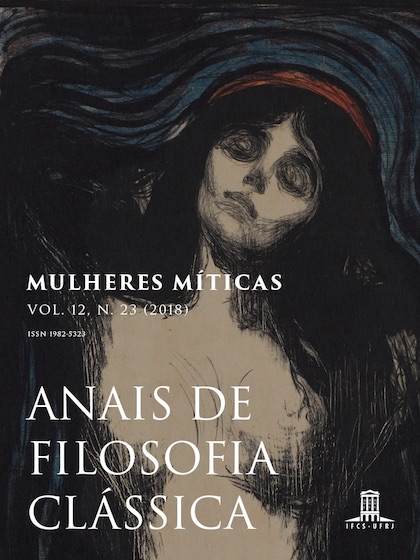Sweet and wild: Artemis (in Aeschylus' Agamemnon)
DOI:
https://doi.org/10.47661/afcl.v12i23.23469Keywords:
Greek Tragedy, Aeschylus, Agamemnon, Artemis, IphigeniaAbstract
The purpose of this paper is to discuss the interpretation of the motive of Artemis’ anger in the parodos of Aeschylus’ Agamemnon. Firstly I will contextualize Artemis’ presence in the parodos when the chorus of Argive elders recalls the omen of the eagles and the hare, which appeared to the fleet just before the ships sail to Troy. Then, I will present the ancient sources’ versions for Artemis’ anger and, subsequently, the interpretations of some renowned scholars. Finally, I will offer my own observations about why Artemis is angry and why the goddess demands the sacrifice of the young Iphigenia.References
Fontes primárias:
AESCHYLUS. Agamemnon. Edited with a commentary by Eduard Fraenkel. 3 vol. Oxford: Clarendon Press, 1982.
APOLLODORUS. The Library. With an English translation by Sir James George Frazer. 2 vol. London, William Heinemann; New York, G. P. Putnam’s Sons, 1921.
CALLIMACHUS. The Hymns. Edited with introduction, translation, and commentary by Susan A. Stephens. New York: Oxford University Press, 2015.
EURÍPIDES. Teatro Completo. Tradução de Jaa Torrano. São Paulo: Ed. Iluminuras, vol 1: 2015; vol 2: 2016; vol 3: 2018.
ESCHILO. Agamennone. Edizione critica, traduzione e commento a cura di Enrico Medda. 3 vol. Roma: Bardi Edizioni, 2017.
ESCHYLE. L’Agamemnon d’Eschyle. Le texte et ses interpretations. Jean Bollack et Pierre Judet de la Combe. 3 vol. Lille: Maison des sciences de l’homme, 1981.
ÉSQUILO. Oresteia. Estudo e tradução de Jaa Torrano. 3 vol. São Paulo: Iluminuras, 2004.
HOMERO. Ilíada. Tradução de Carlos Alberto Nunes. Rio de Janeiro, Ediouro, 2002 [1a. ed. 1945].
PROCLUS. Recherches sur la Chrestomathie de Proclos. IV: La Vita Homeri et les Sommaires du Cycle. Texte et traduction par A. Severyns. Paris, Les Belles Lettres, 1963.
Bibliografia de apoio:
AÉLION, R. Songes et propheties d’Eschyle: une forme de mise en abyme. In: LALLOT, Jean (Ed.) Lalies – Actes des sessions de linguistique et de littérature III, Paris: Presses de l’École Normale Supérieure, 1981, pp. 133-46.
BOUCHÉ-LECLERCQ, A. Histoire de la Divination dans l’Antiquité. Grenoble: Éditions Jérôme Millon, 2003[1879-1882].
CRAHAY, R. La bouche de la vérité. In: VERNANT, J.-P. et al. Divination et Rationalité. Paris: Éditions du Seuil, 1974, pp. 201-219.
DE PAOLI, B. A adivinhação na tragédia de Ésquilo. 2015. 416 ff. Tese (Doutorado em Letras Clássicas) – Departamento de Letras Clássicas e Vernácula, Universidade de São Paulo, São Paulo, 2015.
GRETHLEIN, J. & RENGAKOS, A. (Eds.) Narratology and Interpretation – The Content of Narrative Form in Ancient Literature. Berlin, Walter de Gruyter, 2009.
KNOX, B. M. W. The Lion in the House. Classical Philology, 47, n. 1, 1952, pp. 17-25.
LLOYD-JONES, H. Artemis and Iphigeneia. The Journal of Hellenic studies, 103, 1983, pp. 87-102.
RAEBURN, D. & THOMAS, O. The Agamemnon of Aeschylus – A commentary for students. Oxford: Oxford University Press, 2011.
RIBEIRO JR., W. A. Iphigenia Aulidensis de Eurípides: introdução, tradução e notas. 2006. 297ff. Dissertação (Mestrado em Letras Clássicas) – Departamento de Letras Clássicas, Universidade de São Paulo, São Paulo, 2006.
ROBERTS, D. H. Apollo and his Oracle in the Oresteia. Göttingen: Vandenhoeck & Ruprecht, 1984.
SOMMERSTEIN, A. H. The Tangled Ways of Zeus – And Other Studies in and around Greek Tragedy. Oxford: Oxford University Press, 2010.
VERNANT, J.-P. Parole et signes muets. In: _________. et al. Divination et Rationalité. Paris: Éditions du Seuil, 1974, pp. 9-25.
_________. La mort dans les yeux: figures de l'autre en Grèce ancienne. Paris: Hachette, 1985.
_________. Artémis et le sacrifice préliminaire au combat. Revue des Études Grecques, 101, n. 482- 484, 1988a, pp. 221-239.
_________. A Morte nos Olhos – Figurações do Outro na Grécia Antiga: Ártemis, Gorgó. Rio de Janeiro: Jorge Zahar Editor, 1988b.
_________. & VIDAL-NAQUET, P. Mito e tragédia na Grécia antiga. São Paulo: Perspectiva, 2005.
WERNER, E. Os hinos de Calímaco: Poesia e poética. São Paulo: Humanitas, 2012.


